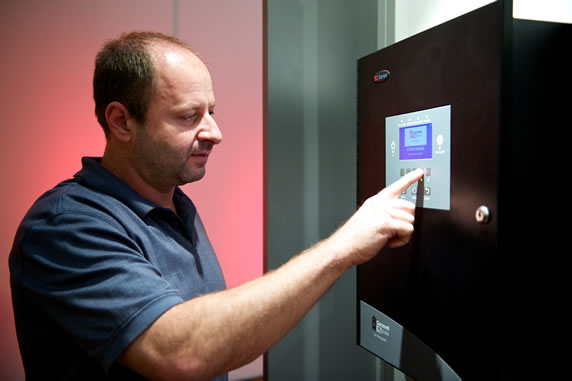
Today’s user-friendly fire alarm systems feature intuitive touch screens that tell the user detailed information about fire events occurring in the building.
At one point or another, most of us, unfortunately, have read or seen news items like this: Yet another “building owner” is responsible for building code violations after a tragic fire at their property. Serious consequences and ensuing lawsuits are a possible outcome when facility owners and managers do not behave responsibly by making sure their buildings are maintained and up-to-code.
As a matter of fact, many boards of directors for high-rise buildings have been sued and even risked bankruptcy because their buildings’ fire alarms were not operating properly and that led to a disaster. As a result, high-rise facility management must place a key emphasis on addressing any fire alarm code violations they may have—if not for the well-being of building occupants, which should be their top priority, but also to protect the property itself, according to Laura Rode, VP of Advanced Fire & Security Inc., which provides installation, inspections and servicing of fire alarm systems, intrusion alarms, video surveillance and access control systems in south Florida.
“Most building owners are not aware that the responsibility of maintaining the fire alarm system falls on them,” Rode says. “If their current system is over 15 years old, they need to seriously start planning for the future and budgeting in the event of catastrophic failure of their current system. If their system should suddenly fail, the cost for the mandated fire watch can oftentimes be as much as the system replacement.”
[pullquote]Oftentimes owners think that if a fire marshal says their system is good when they come by for their annual visit, then they’re 100 percent fine, but that’s not the case.
Linda Rode, Advanced Fire & Security Inc.[/pullquote] As fire alarm systems age, building owners should research code requirements and consider whether replacing the system with a more up-to-date one will be beneficial. Even though their current system may still be acceptable by code, if it’s being held together with band-aids, it can carry a huge liability for the building. If a property manager, owner or board director is aware of ongoing problems with a fire alarm system, yet chooses to overlook them, the insurance company may not cover claims for damages.
“Oftentimes owners think that if a fire marshal says their system is good when they come by for their annual visit, then they’re 100 percent fine, but that’s not the case,” Rode says. “Management shouldn’t just rely on that annual inspection from the fire department. Instead, they should have their systems tested and inspected in accordance with the applicable codes for their jurisdiction by a reputable company who is properly licensed. That company will provide them detailed reports on the functionality of their system and what deficiencies are apparent. It will then be the responsibility of the management to see that those repairs are made in a timely manner.”
When it’s time to replace the fire alarm system, it’s important to look toward a user-friendly fire alarm solution so all who have to use the system have no trouble understanding it. Many companies promote systems with “lots and lots of buttons because it looks really high-tech,” says Rode, but she adds that these overly complicated systems can overwhelm users (and oftentimes first responders). At the very least, consider a practical and easy-to-use system with a simple keypad that explains in plain English exactly what’s happening in the high-rise. She recommends today’s more user-friendly systems, featuring intuitive touch screens that tell the user detailed information about fire events occurring in the building. In today’s world of technology, a building’s life safety system should be nearly as user-friendly as a smart phone.
With high-rise facilities being built taller and taller, building owners need to consider the difficulties of evacuating a building without panicking its occupants. What good is a system if the occupants can’t hear or understand it? Management must look for a voice evacuation system that provides specific information on the alarm and allows first responders to provide specific instructions for how occupants should respond—such as what stairways they can access to exit the building. These voice systems must be intelligible, according to Rode, and the newer code books recognize and address this. The occupants must be able to understand what is being said; many older voice systems or even new systems are not being designed to offer clear audio, so messages are garbled and cause confusion when activated. Newer and more advanced systems take this intelligibility into account, according to Rode.
Lastly, what else should high-rise facility management know about fire alarms? According to Rode, facility managers and security directors should receive continual training. Too many times, Rode has witnessed situations in which security guards respond to alarms by immediately silencing them, assuming the alarms are nuisance ones. She says they go back to work without checking whether the fire alarm went off for some reason, potentially for a real fire somewhere in the building. Instead of quickly shutting off the alarm, she recommends that employees be trained to let the fire alarm ring until the fire department responds and the cause is investigated. Many are only trained when they’re hired, whereas ongoing education should be the case. Without continual training, these employees might panic during a true emergency and endanger the building’s occupants. Keep a log book of employee training, Rode says, because you are more likely to follow through on it if it’s routinely maintained.
Brian Carlson
Brian Carlson is the Strategic Marketing Manager for Gamewell-FCI.

